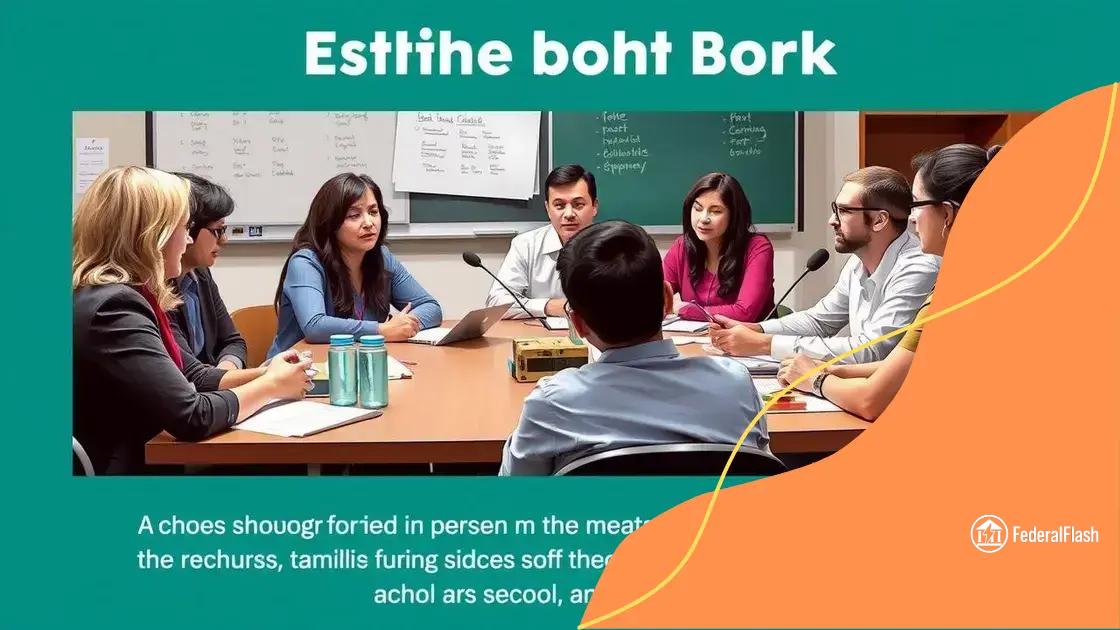Examining the influence of political ideologies on education policy

Anúncios
Examining the influence of political ideologies on education policy reveals that these ideologies shape curriculum choices, funding distribution, and resource allocation, significantly impacting the educational landscape across different states.
Examining the influence of political ideologies on education policy invites us to explore how different beliefs shape our classrooms. Have you ever wondered why some topics are prioritized over others in schools? Let’s dive deeper into this intriguing issue.
Anúncios
The role of political ideologies in shaping education
The role of political ideologies in shaping education is significant. These ideologies influence not only what is taught in schools but also how students perceive the world around them. Understanding this can help us see the bigger picture of education.
Understanding Different Ideologies
Each political ideology proposes different approaches to learning and knowledge. For instance, conservative ideologies often emphasize traditional values, while liberal views may promote progressive education. These fundamental beliefs guide education policy decisions.
- Conservatives may support structured learning environments.
- Liberals are likely to advocate for inclusivity and diverse perspectives.
- Both approaches can lead to debate over curriculum choices.
As societies evolve, the influence of these political ideologies becomes even more pronounced. Educational reforms are often driven by shifts in political power, affecting funding and resource allocation. For instance, when a conservative government is in power, we may see increased emphasis on core subjects such as math and science. Conversely, a more liberal administration might focus on integrating social issues into the curriculum.
Anúncios
Impact on Curriculum and Teaching Methods
How political ideologies shape the curriculum is crucial. The selection of textbooks, teaching methodologies, and classroom discussions can all reflect ideological beliefs. This can lead to polarization among students, as different viewpoints collide in an educational setting.
- Textbooks may present history from a biased perspective.
- Teaching methods can vary dramatically based on ideology.
- Classroom environments may encourage certain political beliefs over others.
It is essential to acknowledge that the role of political ideologies is not inherently negative. Instead, it can lead to enriched discussions and critical thinking, providing students with diverse viewpoints. Ultimately, the challenge lies in balancing these ideologies to promote an inclusive educational atmosphere.
How left and right ideologies influence curriculum decisions
The way left and right ideologies influence curriculum decisions can significantly impact what students learn in schools. Each side has its perspective, leading to different emphases in education. Understanding both sides helps to recognize the overall educational landscape better.
Influence of Left Ideologies
Left-leaning ideologies often advocate for inclusivity and diversity in the curriculum. These ideologies push for courses that reflect various cultures and social issues. For example, they may support the inclusion of topics like feminism, environmental justice, and multicultural education.
- A focus on social justice and equity.
- Promotion of critical thinking about societal issues.
- Inclusion of diverse historical perspectives.
This approach aims to empower students to understand their roles in society and advocate for change. Students learn to analyze critical social issues and think independently.
Influence of Right Ideologies
On the other hand, right ideologies typically emphasize traditional values and core subjects. These ideologies often prioritize subjects like math, science, and literature over social issues. They may aim to preserve historical narratives that reflect national pride and cultural heritage.
- Emphasis on standards and accountability in education.
- Focus on mastery of fundamental skills.
- Promotion of patriotic values in history education.
For supporters of right ideologies, education should cultivate discipline and respect for authority. They believe students benefit from a structured learning environment that supports personal responsibility.
The interplay between these ideologies leads to ongoing debates over education policies and practices. Understanding how each perspective shapes curriculum choices helps parents, educators, and policymakers navigate the complex field of education.
Effects of political agendas on funding and resources

The effects of political agendas on funding and resources in education are profound. Different political parties often have varying priorities for where resources should be allocated. These decisions can shape the educational landscape significantly.
Funding Allocation
Political agendas influence how funding is distributed across schools and districts. For example, a government prioritizing education may increase funding for public schools, enhancing facilities and resources. In contrast, a more conservative agenda may focus on reducing taxes, which can lead to budget cuts in education.
- Increased funding can support teacher salaries and professional development.
- Resources for technology and infrastructure improve student experiences.
- Budget cuts often lead to larger class sizes and fewer support staff.
These funding changes can create disparities between schools in different regions or communities, affecting student outcomes significantly. Often, political agendas create a tug-of-war between urban and rural areas, where one may receive more attention and resources than the other.
Resource Distribution
Resources are not only about money; they also include materials, technology, and access to extracurricular activities. A political focus on equitable education pushes for a fair distribution of these resources. This agenda seeks to ensure that all students, regardless of background, have access to quality education.
- Access to updated textbooks and teaching materials is essential.
- Technology in the classroom can enhance learning experiences.
- Extracurricular programs foster skills and critical thinking.
However, when political agendas shift, the commitment to equitable distribution of resources can waver. Decisions made at the top often ripple down and directly impact students’ educational experiences.
Understanding how political agendas shape funding and resource allocation helps stakeholders advocate for better policies. By recognizing these effects, educators, parents, and policymakers can work together to create a more equitable educational environment.
Case studies on ideological impacts in different states
Exploring case studies on ideological impacts in different states reveals how political beliefs shape education systems across the country. Each state has unique challenges and approaches influenced by its dominant political ideology.
Case Study: California
In California, a progressive agenda has led to a focus on holistic education. Schools prioritize mental health and social-emotional learning, encouraging cultural awareness among students. This approach has resulted in a curriculum that integrates diverse perspectives and emphasizes inclusivity.
- Programs supporting LGBTQ+ education.
- Curricula addressing climate change and social justice.
- Funding for mental health resources in schools.
The impact of this ideological stance is evident in student engagement and academic performance, showcasing the effectiveness of inclusive policies.
Case Study: Texas
Conversely, Texas reflects a more conservative stance, with education policies emphasizing traditional curricula and parental choice. Here, school vouchers and charter schools are promoted, allowing parents to select educational options best suited for their children.
- Focus on core subjects like math and science.
- Limited inclusion of socially progressive topics.
- Promotion of American history from a patriotic perspective.
This ideological environment often leads to debates over educational content, particularly regarding topics like evolution and American history.
These case studies illustrate the impact of political ideologies on education. Challenges and successes vary significantly based on the dominant beliefs and values within each state. For stakeholders, understanding these differences is crucial in advocating for effective educational policies.
Future trends in education policies influenced by ideology
Examining future trends in education policies influenced by ideology provides insight into how political beliefs will shape the education system. As society evolves, so do educational approaches, reflecting shifting values and priorities.
Increased Focus on Social Justice
One significant trend is the growing emphasis on social justice in education. This shift encourages curriculums that address equity and inclusion, aiming to ensure all students have a fair chance to succeed. Schools may implement programs that focus on underrepresented voices and histories.
- Curriculums may integrate topics like racial equity and gender studies.
- Policies may promote diversity among teaching staff.
- Schools might adopt restorative justice practices over traditional disciplinary measures.
This trend can empower students to become advocates for change in their communities.
Technological Integration
Another trend involves the increased integration of technology in education. With the rise of online learning and digital resources, schools are adapting their strategies. The blending of technology with traditional teaching can enhance learning experiences, offering students flexible options.
- Personalized learning experiences through adaptive technologies.
- Increased access to resources regardless of location.
- Greater emphasis on digital literacy skills.
As educational policies adapt to technological advances, we may see new guidelines focused on digital equity to ensure all students can benefit from these changes.
Political ideologies will continue to play a crucial role in shaping these trends. Stakeholders must remain aware of how ideologies influence policy decisions, promoting a future where education reflects the diverse needs of students.
In conclusion, understanding the influence of political ideologies on education policy is essential for everyone involved in education. The differences between left and right ideologies significantly impact curriculum choices, funding, and resource allocation. As we move forward, the educational landscape will likely continue to change, reflecting new trends such as a focus on social justice and the integration of technology. By recognizing these dynamics, educators, policymakers, and community members can advocate for a more equitable and effective educational system that meets the needs of all students.
FAQ – Questions Frequently Asked About the Influence of Political Ideologies on Education Policy
How do political ideologies influence curriculum decisions?
Political ideologies affect what topics are emphasized in school curriculums, reflecting the values and beliefs of those in power.
What impact does funding have on education policies?
Funding allocation can lead to disparities in resources and opportunities for students, often influenced by the political climate.
What are some future trends in education policies?
Future trends include a greater focus on social justice in education and the integration of technology into the classroom.
How can stakeholders advocate for equitable education?
Stakeholders can advocate by engaging with policymakers, promoting inclusivity, and ensuring that all students have access to quality education.